THE KINAHANS
How a dark reimagining of ‘Dumbo the Elephant’ shaped the business dealings of an Irish drug lord
Decades before Christopher Kinahan Sr. fled to Dubai, he dabbled in prison poetry and prose alongside some of Ireland’s most notorious criminals — including remorseless killer Dessie O’Hare.
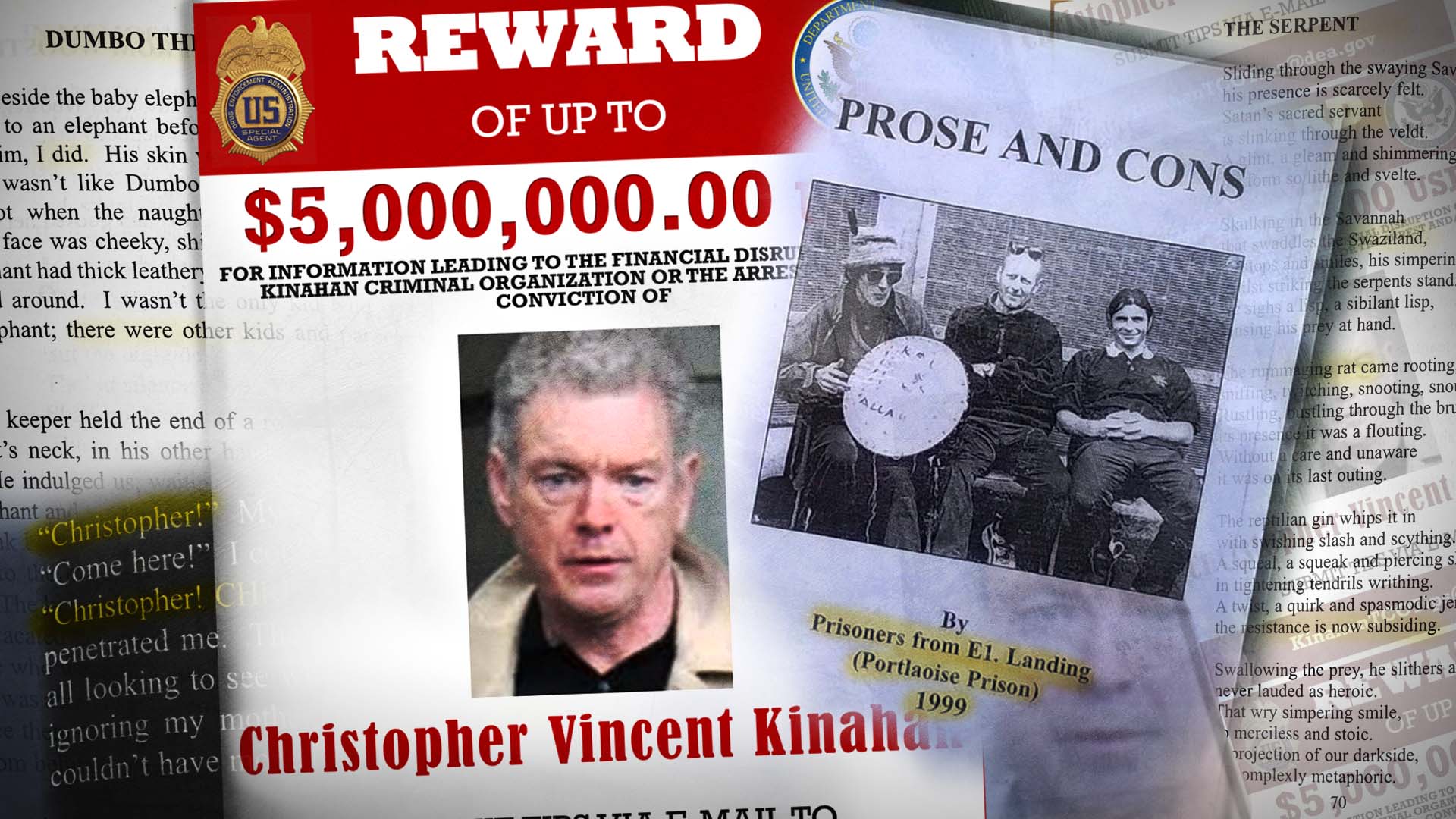
You could call it the Deadly Poets Society.
As he rose to become a cartel godfather, Christopher Kinahan Sr. wrote and edited poetry and prose under a pen name as part of a high-security prisoners’ writing group that included a killer with mystical pretensions.
And, in a twist fit for a thriller, Kinahan later named two of his companies with the same nom de plume he had used as the editor-of-choice for feared Irish felons: Cian Sharkhin — an anagram of Chris Kinahan.
U.S. authorities have offered rewards of up to $15 million for information that leads to the arrest and conviction of Kinahan and his sons, Daniel Kinahan and Christopher Kinahan Jr. The trio is accused of leading one of Europe’s most notorious gangs, a narcotics, money laundering and arms-trafficking cartel with ties to Asia, Latin America and the Middle East.
In 1999, while serving a four years sentence for receiving stolen traveler’s checks, the future drug lord was moved to Portlaoise Prison, a high-security facility one hour’s drive from the Irish capital, Dublin. Christopher Kinahan Sr. was housed on E1 landing with serious criminals known to staff and prisoners as “the heavies.” A landing is an area or level within a prison where cells are located. On the landings above them were paramilitary members of the Irish National Liberation Army and the Provisional IRA, or Provos.
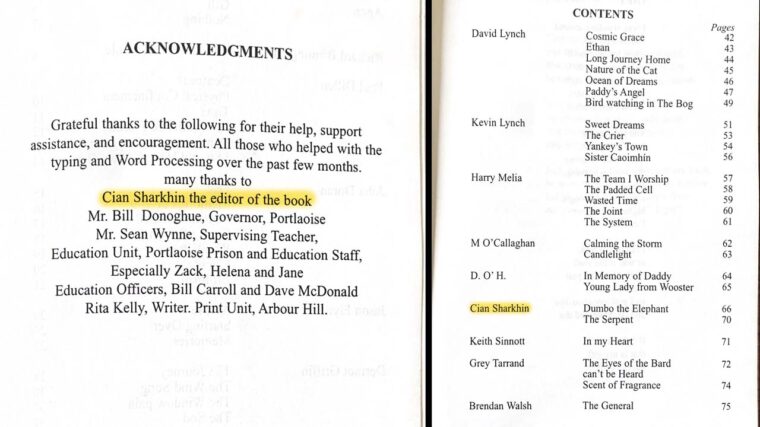
While incarcerated, Kinahan edited the artfully titled “Prose and Cons,” a slim anthology of writings on loss, longing, love, admiration, addiction and rage by E1 landing prisoners. Under the guise of Cian Sharkhin, Kinahan also contributed a dark short story, “Dumbo the Elephant,” and a sibilant poem, “The Serpent,” to the poetry and prose pamphlet.
“Dumbo the Elephant” is a very different beast to Disney’s animated classic about embracing individual differences and the uplifting power of self-belief. On the contrary, Kinahan’s story recounts the frightening experience of a young boy named Christopher who is pinned underfoot by a lurching “bark-skinned” baby elephant with “sad piggy little eyes.”
Young Christopher’s ordeal is compounded by his mother screaming at him while his foot is trapped under Dumbo, causing a zookeeper to “thwack” the elephant with his cane to free the boy.
“Christopher! Christopher!” Her voice 10 decibels higher penetrated me,” Sharkhin — aka Kinahan — writes of the possessed-with-fury mother figure in the story.
“The small crowd looked around at each other, all looking to see who Christopher was, I guessed. I joined in, ignoring my mother, not a good idea at the best of times …
“She came striding towards me, or should I say that possessed creature that was once my mother and now like Mary the mad Maenad came bouncing towards the crowd, her hair was flouncing up and down …
“That look said it all ‘You Dare Defy Me!’ I stared back at the Maenad, I felt small, insignificant and terrified. The silence screamed in my ears, the spell was shattered by a squeaky little voice that rose up above the deafening silence. ‘I can’t move’.
“The Maenad’s merciless eyes kept me fixed, only her lips twitched and twisted into a grim unholy grimace, those eyes with their feral bloodlust were unhinging. The corner of one of her eyes began to twitch uncontrollably. She was poised to strike.”
In Greek mythology, the Maenads are frenzied female followers of the god Dionysus who accessed a state of divine madness and ecstasy through wine, dancing and sex.
Mary, the Dublin Maenad, retreats after young Christopher is freed, his mother softening in “Doris Day light” to groom his “curly blond tresses,” becoming “a study of divinity, a Madonna.” But young Christopher is haunted by his “act of treachery” after causing “poor old Dumbo” to be hit with a long bamboo stick.
Born in 1957 in West London, Kinahan grew up in a lower middle-class family in Dublin, and was doted on by his sisters Denise, Maria and Sally Anne. Like the character in his short story, Kinahan’s real mother was named Mary. Young Christopher only had two fictional sisters, though, Denise and Sally, who held hands as the baby elephant lurched.
Kinahan’s poem “The Serpent” is a dark and alliterative ode to a svelte and shimmering reptile with a sibilant lisp who is sniffling, snooting, snouting, skulking, simpering and stoic in the Swaziland savanna. The poem begins:
“Sliding through the swaying Savannah
His presence is scarcely felt.
Satan’s sacred servant
Is slinking through the veldt.
A glint, a gleam and shimmering sheen,
His form so lithe and svelte.”
Forensic psychiatrists could pore over Cian Sharkhin’s varied musings on “the darkest recesses” of his mother’s Id and a “complexly metaphoric” serpent for insights into his alter ego. As fate would have it, decades after his foray into poetry inspired by Africa, Kinahan established a hideout in Zimbabwe, a largely savanna region home to vipers, adders and cobras.
‘The Don,’ the fox and friends
As Cian Sharkhin, Kinahan edited the poetry of two of Ireland’s most infamous paramilitaries turned criminals, Dessie “The Border Fox” O’Hare and Eamon Kelly.
A confessed killer, Dessie O’Hare was once Ireland’s most hunted man and has been linked to 27 murders. In 1987, he kidnapped a dentist, John O’Grady, and chopped off the tips of two of his fingers using a hammer and chisel. O’Hare had demanded a large ransom that wasn’t paid. He told police in a ransom call: “It’s just cost John two of his fingers. Now I’m going to chop him into bits and pieces and send fresh lumps of him every fucking day if I don’t get my money fast.”
After a 23-day hunt by Irish police, baby-faced O’Hare was tracked down in Urlingford, County Kilkenny, where he was shot several times by an Army sniper but survived. O’Hare, who spoke in a quiet, inoffensive tone, and claimed in 1986 to have become a pacifist after studying the works of Martin Luther King Jr. and Gandhi, later used a bolt cutter to remove a feuding comrade’s ear before shooting him dead.
David McDonald, a former Portlaoise Prison officer, told the International Consortium of Investigative Journalists that Kinahan’s gift with words and tactical nous made him stand out — even among his feared prison contemporaries.
McDonald said Kinahan, known as “The Don,” mostly kept to himself and never had an interest in “prison hooch” or drugs. Instead, he was an early adopter of the internet, which he accessed on a smuggled mobile phone.
“He was organized, intelligent and always impeccably dressed in shirts and slacks, as if he was going to a wedding,” said McDonald, who is acknowledged by name in the “Prose and Cons” pamphlet. Inmates in Portlaoise Prison could wear their own clothes if they maintain them adequately and have enough to change regularly.
[Kinahan] was organized, intelligent and always impeccably dressed in shirts and slacks, as if he was going to a wedding.
— former Portlaoise Prison officer David McDonald
“Kinahan studied Spanish, Russian and one other language while in prison and, remarkably, he refused early release because he wanted to finish his studies in prison where he had fewer distractions,” McDonald added.
McDonald said other inmates would seek Kinahan out for advice on their legal problems, describing him as “a jail lawyer” because he was “in a totally different intellectual league.”
Back then, the man who now leads a cartel linked to numerous murders in several countries was not prone to the vicious outbursts that would come later. “There was never any suggestion of violence with him,” McDonald said. “You wouldn’t trust him as far as you could throw him but he wasn’t trouble.”
As for O’Hare, McDonald remembered him as one of the most unusual prisoners he ever met.
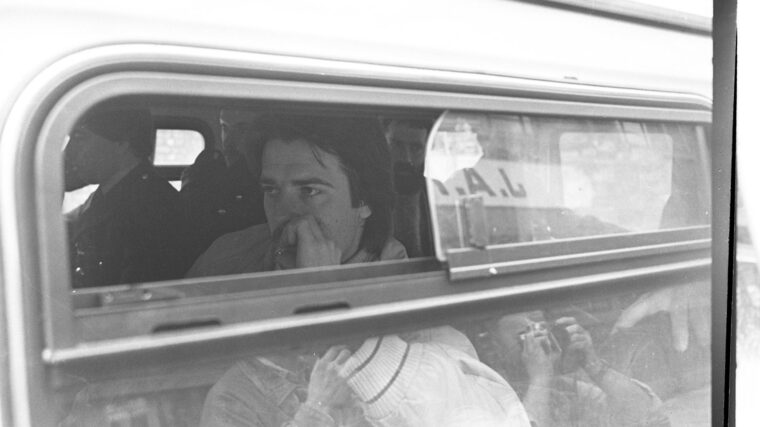
O’Hare earned his nickname, “The Border Fox,” for the way he slipped back and forth across the Republic of Ireland’s 300-mile border with Northern Ireland during his violent sprees in the 1970s and 1980s.
McDonald said O’Hare, who was released from Portlaoise Prison last year after serving another five years for false imprisonment, had a keen interest in meditation, yoga and mysticism. “Dessie O’Hare did the drawings for ‘Prose and Cons,’ ” McDonald said. “He was a deep character, and the last person I spoke to before leaving the prison service, as he invited me into his cell for a cup of tea.”
McDonald added, “O’Hare, told me that at night his soul would leave the prison and travel to the hills of Donegal.” Donegal is a beautiful county in Ulster, the province where O’Hare grew up.
Recognized for his many killings, rather than his killer humor, the contrarian O’Hare contributed a saucy limerick to the pamphlet called “Young Lady From Wooster”:
“There was a young lady from Wooster,
Who dreams a rooster seduced her,
She woke with a scream
But ‘twas only a dream,
A bum in the mattress had goosed her.”
In a nod to his own bizarre mystical interests, O’Hare takes authorship of the limerick as “D O’H, from an Indian Guru.”
Never the romantic, O’Hare once shot his estranged wife in the thigh when they reportedly argued outside a bar in Dunleer, County Louth, north of Dublin, over another man.
Kinahan also served time and was friendly with Eamon Kelly, a one-time paramilitary turned drug dealer and crime gang boss, whose closeness to O’Hare would ultimately endanger his life.
Kinahan and Kelly used to walk the exercise yard together, according to McDonald, the former prison officer.
Kelly, an armed robber and drug trafficker, chose the photos for “Prose and Cons” along with another gangster, Harry Melia.
In December 2012, Kelly was shot dead near his home in the Dublin suburb of Killester. The New IRA, sworn enemies of Kelly’s friend O’Hare, claimed responsibility.
O’Hare, who made and sold Irish drums, ceramics and wooden ornaments and clocks in between prison stints, spoke at Kelly’s funeral and carried his coffin.
Cian Sharkhin’s companies
Kinahan holds U.K. and Irish passports and speaks with an Anglo-Irish accent. Having spent 11 of the previous 15 years incarcerated, he was released from prison in 2001.But his pen name lived on.
In April 2002, Kinahan and his then wife, Jacqueline, created Cian Sharkhin Developments Limited in the United Kingdom, according to company records. The company is now closed.
In the same year, the couple set up a hair and beauty company called Total Tanning Centres Limited in Tamworth, outside Birmingham, home to the Kinahan cartel’s U.K. arm.
Following an anonymous tip, ICIJ also discovered that Kinahan used a small Cypriot accountancy firm to create a second company, called Cian Sharkhin Consultants Limited, in 2005.
In a curious phonemic twist, records show that when creating the consultancy, Kinahan used the name “Christopher Vincent Kinaham,” swapping the “n” for an “m.”
Both Kinahan and Kinaham share the same date of birth, March 23, 1957, according to documents, including Kinahan’s passport, and the same U.K. passport number.
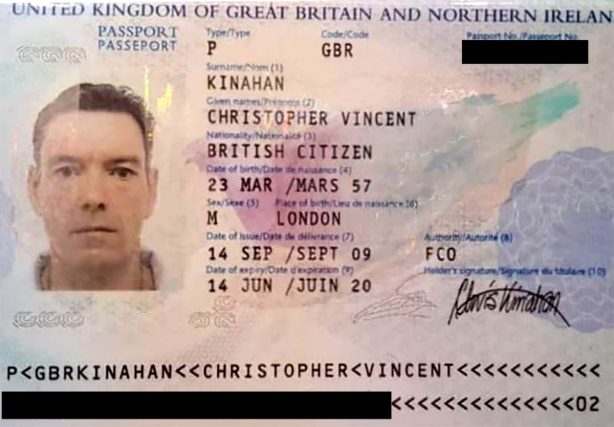
The cartel boss used the address in Ephesus Street, Paralimni, Cyprus of his accountant, Demetris Papademetriou, when setting up Cian Sharkhin Consultants Limited.
Cian Sharkhin Consultants Limited has a LinkedIn page that names its owner as Vincent Kinahan. It did not respond to questions from ICIJ.
Papademetriou has a family practice with an office in Paralimni, a city of 20,000 people in the southeast of the island state, roughly 50 miles from the capital Nicosia.
Papademetriou’s company, DPCA, has provided services for other Kinahan-related companies. Those include D&M Sun Dream Investments Limited and A.B. Eureka Property Developers Limited.
Kinahan did not respond to questions from ICIJ.
DPCA and Papademetriou also did not respond to questions from ICIJ.
Papademetriou is a graduate of Manchester University and Manchester Business School. His company’s slogan is: “Of course we can!”
D&M Sun Dream was created in 2005 by Christopher Kinahan’s son and fellow cartel leader, Daniel, who is sanctioned by the U.S., and his associate, Matthew Dunne.
A.B. Eureka was established the same year by Christopher Vincent Kinaham, again with an “m.” A British woman held a 16.67% share in the company as of 2022.
The Institute of Certified Public Accountants of Cyprus did not respond to questions.
Previously, ICIJ has reported how the elder Kinahan abbreviated his name to Christopher Vincent and used his initials CVK when naming several companies, such as CVK Investments.
Kinahan has lived in the United Arab Emirates, the U.K., Spain, Belgium, the Netherlands, Zimbabwe, Cyprus and elsewhere, and reportedly speaks Spanish, French, Dutch and Russian. He is married to a Turkish national, Neslihan Yildirim, whom he is believed to have first met in the Netherlands and reportedly lived with in Zimbabwe before settling in Dubai.
The Kinahans are believed to be living freely in Dubai, where authorities have frozen Kinahan assets and blocked the sale of property owned by Kinahan family members and companies under sanctions by the U.S. But, as ICIJ reported in May 2024, the sanctions don’t include some spouses and partners, which renders them less effective.
From Disney to Dublin
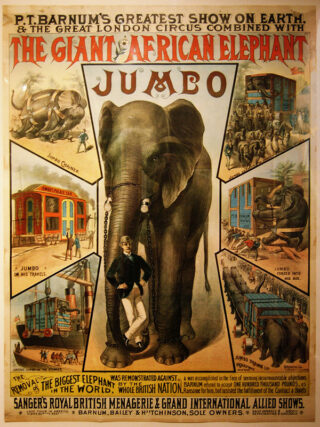
Disney released the animated film “Dumbo” on Oct. 23, 1941, and was met with critical acclaim.
The character Dumbo was inspired by a 19th-century animal superstar, Jumbo, who drew crowds in their millions to Jardin des Plantes in Paris, the London Zoo, and P.T. Barnum’s travelling circus in the U.S.
More reminiscent of Kinahan’s somber “Dumbo the Elephant,” than Disney’s merry one, Jumbo did not live a happy life — separated from his mother by hunters, the elephant was routinely sedated with vast amounts of alcohol during his life in captivity.
But perhaps Kinahan’s tale drew inspiration from another elephant, Sita, the star attraction at Dublin Zoo, near where Kinahan grew up, until a fateful summer morning in June 1903, when the elephant killed veteran zookeeper James McNally by crushing his skull under her foot.
Despite appeals for clemency for the elephant, she was deemed a dangerous animal by the Zoo Society, and was subsequently shot to death by members of the Royal Irish Constabulary’s musketeers.
Sita’s hind foot was mounted, bearing the inscription:
“SITA,”
Who killed her keeper and was shot by a party of the
ROYAL IRISH CONSTABULARY
On 11th June, 1903.
Presented by COLONEL SIR NEVILLE CHAMBERLAIN.